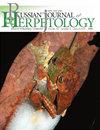以色列地中海沿岸岛屿第一次爬行动物调查结果
IF 0.9
4区 生物学
Q3 ZOOLOGY
引用次数: 0
摘要
地中海的小岛通常是爬行动物的家园,通常代表着大陆动物群的贫困样本,但种群密度高,有快速形态和行为进化的迹象。在这篇论文中,我们首次对以色列地中海海岸附近的几个小岛群进行了爬行动物动物调查,这些小岛群最近才在地质上与大陆分离。2017年至2018年3月,我们对五个小岛进行了调查,并记录了四个调查小岛上存在五种不同的爬行动物。物种丰富度在1至4种之间变化,似乎与岛屿面积相关,具有明显的嵌套结构。爬行动物可能是通过附近沿海种群的自然扩散,或通过搭渔船和类似的人类辅助扩散方法在小岛上定居的。或者,记录在案的爬行动物可能代表了早期地质时期的残余种群,当时较低的海平面支撑着小岛和大陆之间的连续陆桥。这些岛屿爬行动物种群需要进一步研究,以确定确切的定殖方式,并描述它们是否以及如何与大陆种群不同。我们强调这些地中海小岛作为独特生物多样性中心的重要性,并鼓励未来针对它们和类似小岛的研究和保护行动。本文章由计算机程序翻译,如有差异,请以英文原文为准。
Results of the First Herpetological Survey of Israel’s Mediterranean Coastal Islets
Small islets in the Mediterranean Sea are often home to reptiles, typically representing an impoverished sample of the continental fauna, yet with high population densities and signs of rapid morphological and behavioral evolution. In this paper, we present the first herpetofaunal survey of several small islet clusters in close proximity to the Mediterranean coast of Israel, only recently geologically separated from the mainland. We performed surveys of five islets during March of 2017 – 2018 and recorded the presence of five different species of reptiles on four of the surveyed islets. Species richness varied between 1 and 4 species, and appeared to be correlated with island area, with a distinct nested structure. Reptile species may have colonized the islets by natural dispersal from nearby coastal populations, or by hitch-hiking on fishing boats and similar methods of human-assisted dispersal. Alternatively, the recorded reptiles may represent relictual populations from earlier geologic periods, when lower sea-levels supported continuous land-bridges between the islets and the mainland. These insular reptile populations require further study to establish the exact means of colonization and describe if and how they differ from mainland populations. We stress the importance of such small Mediterranean islets such as these as centers of unique biodiversity and encourage future study and conservation action aimed at them and similar islets.
求助全文
通过发布文献求助,成功后即可免费获取论文全文。
去求助
来源期刊

Russian Journal of Herpetology
ZOOLOGY-
CiteScore
1.70
自引率
0.00%
发文量
29
期刊介绍:
Russian Journal of Herpetology is an international multi-disciplinary journal devoted to herpetology. Russian Journal of Herpetology accepts original papers on ecology, behavior, conservation, systematics, evolutionary morphology, paleontology, physiology, cytology and genetics of amphibians and reptiles.
Types of Contributions:
-original papers
-invited or contributed reviews on specific topics
-short communications on topics of immediate interest, new methods and ideas in progress
-notices of meetings, symposia, and short courses
-book reviews
 求助内容:
求助内容: 应助结果提醒方式:
应助结果提醒方式:


